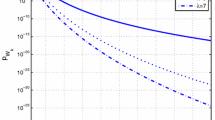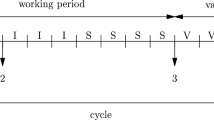Abstract
We use the Method of Collective Marks to analyze some time-dependent processes in theM/G/1 queue with single and multiple vacations. With the server state specified at a fixed timet>0, the Laplace transforms with respect tot of mixed transforms for the joint distribution of the number of departures by timet, the queue length, the virtual waiting time, the elapsed and remaining service/vacation times at timet are derived by means of probabilistic interpretations. The Laplace-Stieltjes transform of the virtual waiting time at timet is also given. Some well known results are special cases.
Similar content being viewed by others
References
A.R. Bloemena, On queueing processes with a certain type of bulk service, Bull. Inst. Int. Statist. 37 (1958) 219–227.
E.A. Danieljan,M/G/1/∞-queueing model with unit traffic-intensity in continuous time, Rostock Math. Kolloq. 32 (1987) 67–86.
E.A. Danieljan and F. Liese, Mr/Gr/l/∞ model with time dependent priorities, Rostock Math. Kolloq. 43 (1991) 39–54.
D. van Dantzig, Sur la méthode des fonctions génératrices, Colloques internationaux du CNRS 13 (1949) 29–45.
D. van Dantzig, Chaines de Markof dans les ensembles abstraits et applications aux processus avec régions absorbantes et au problème des boucles, Ann. Inst. H. Poincaré 14 (1955) 145–199 (English version exists).
B.V. Gnedenko, E.A. Danieljan, B.N. Dimitrov, G.P. Klimov and W.F. Matvejev,Service Systems with Priorities (Moscow University, Moscow, 1973) (in Russian).
H. Kesten and J.Th. Runnenburg, Priority in waiting-line problems I and II, Indag. Math. 19 (1957) 312–336.
Y. Levy and U. Yechiali, Utilization of idle time in anM/G/1 queueing system, Manag. Sci. 22 (1975)202–211.
J.Th. Runnenburg, Probabilistic interpretation of some formulae in queueing theory, Bull. Inst. Int. Statist. 37 (1958) 405–414.
J.Th. Runnenburg, On the use of the Method of Collective Marks in queueing theory, in:Congestion Theory, eds. W.L. Smith and W.E. Wilkinson (Chapel Hill, 1965).
J.Th. Runnenburg, Van Dantzig's Collective Marks revisited, in:Proc. Bicentennial Congress Wiskundig Genootschap, eds. P.C. Baayen, D. van Dulst and J. Oosterhoff (Mathematisch Centrum, Amsterdam, 1979).
D. Sikkel, Joint distributions in one-server queues, with the Method of Collective Marks, final exam paper, University of Amsterdam (1975) (in Dutch).
L. Takâcs,Introduction to the Theory of Queues (Oxford University Press, New York, 1962).
H. Takagi, Time-dependent analysis ofM/G/1 vacation models with exhaustive service, Queueing Syst. 6 (1990) 369–390.
H. Takagi, Time-dependent process ofM/G/1 vacations with exhaustive service, J. Appl. Prob. 29 (1992) 418–429.
Author information
Authors and Affiliations
Additional information
This research was supported by the University of Amsterdam.
Rights and permissions
About this article
Cite this article
Cong, T.D. Application of the method of collective marks to someM/G/1 vacation models with exhaustive service. Queueing Syst 16, 67–81 (1994). https://doi.org/10.1007/BF01158949
Received:
Revised:
Issue Date:
DOI: https://doi.org/10.1007/BF01158949




